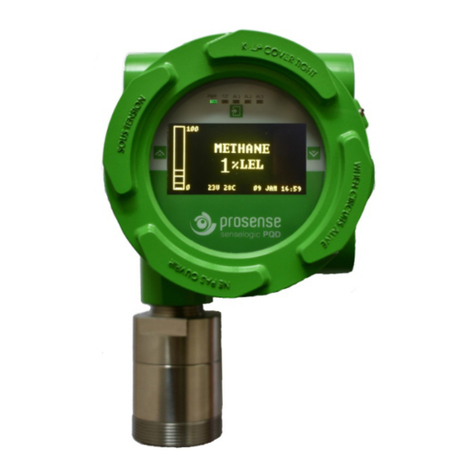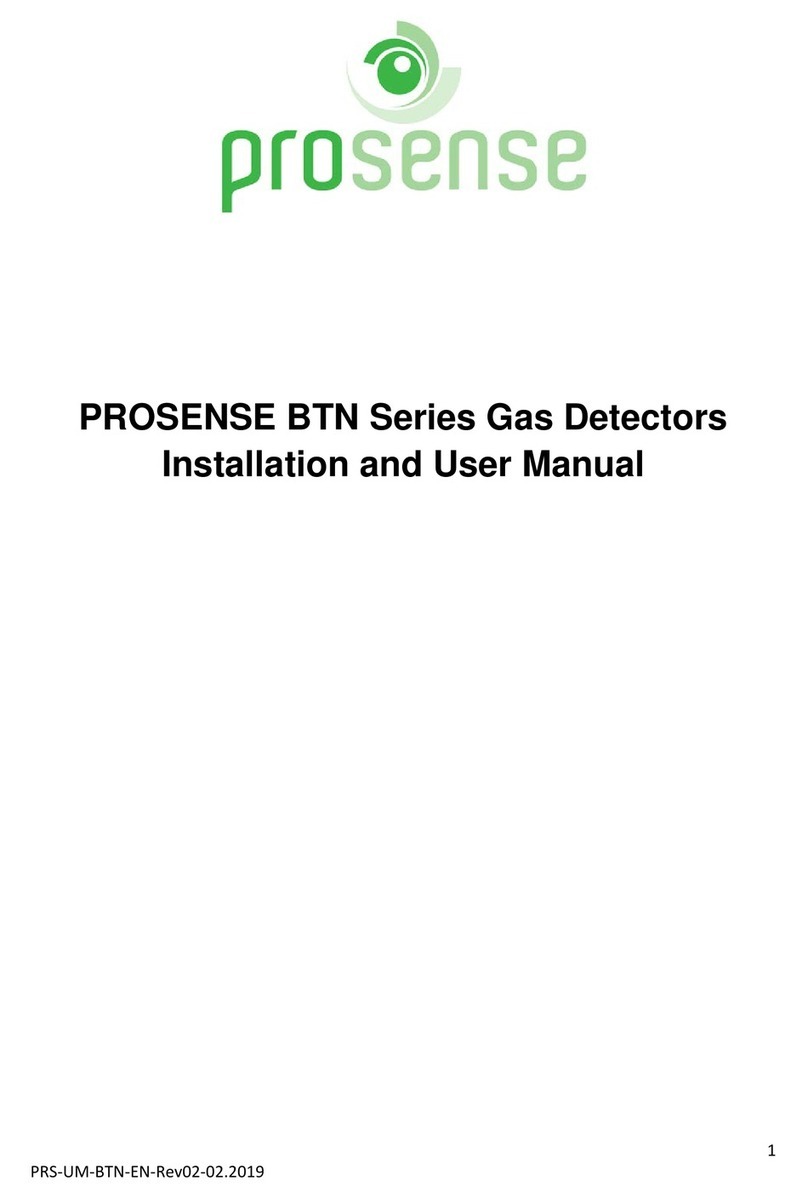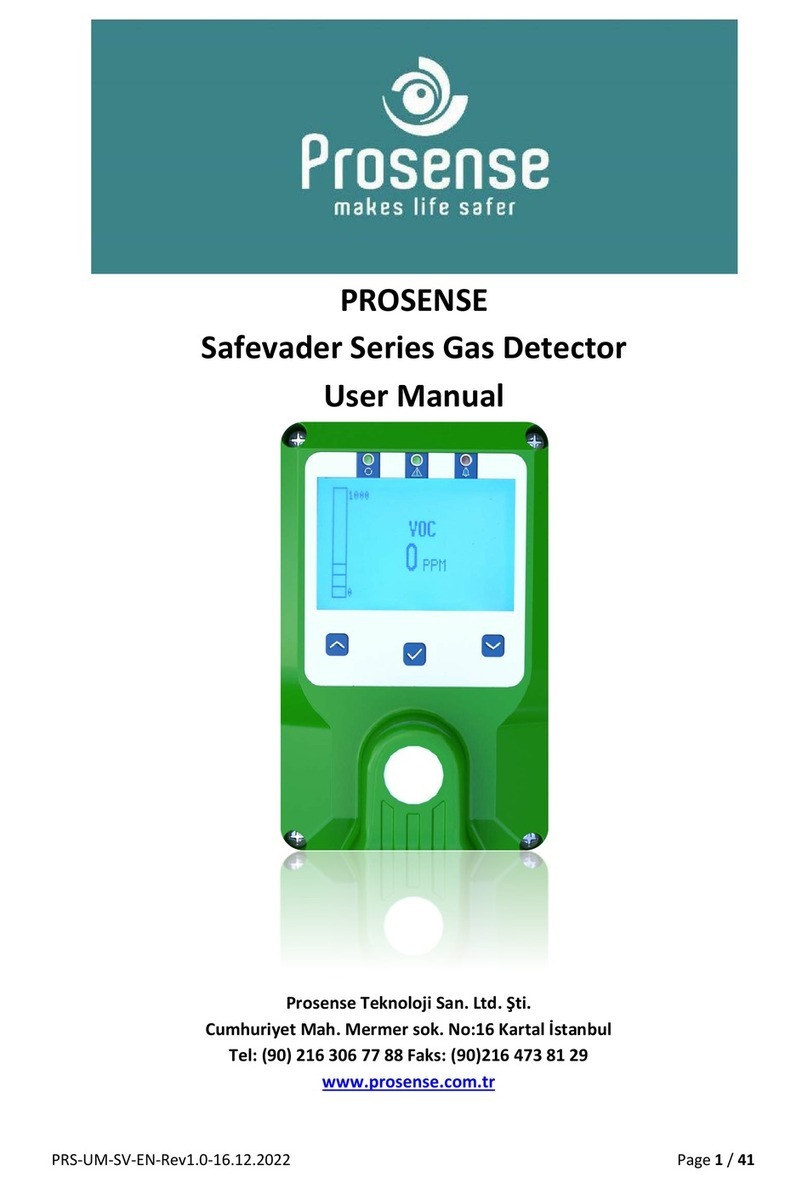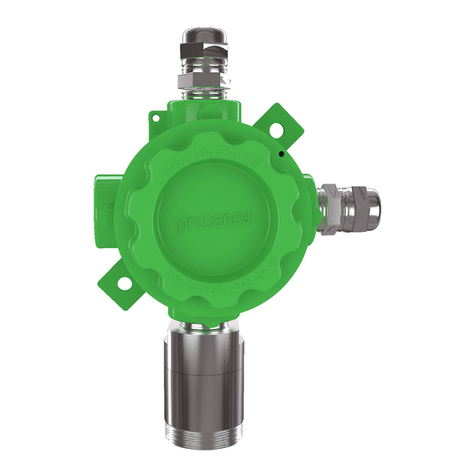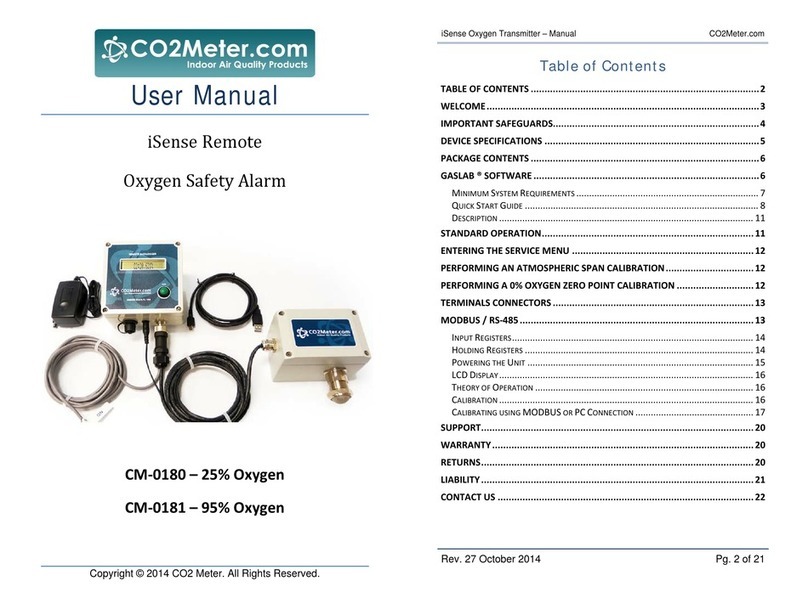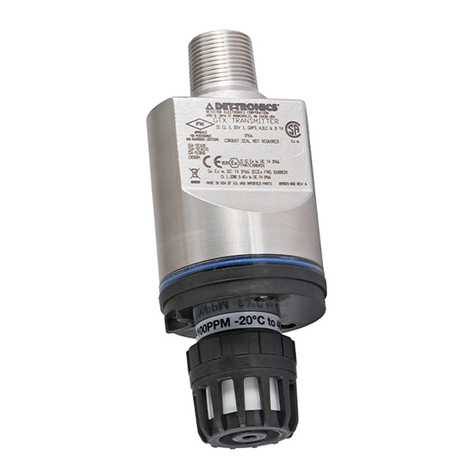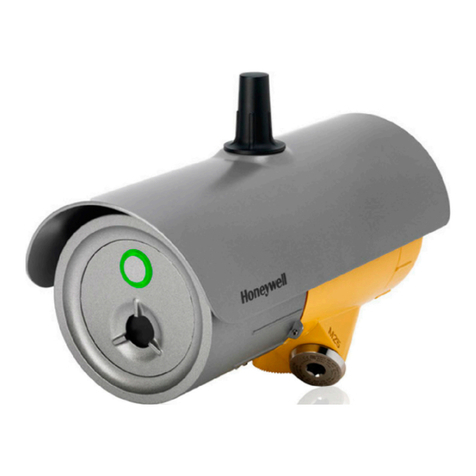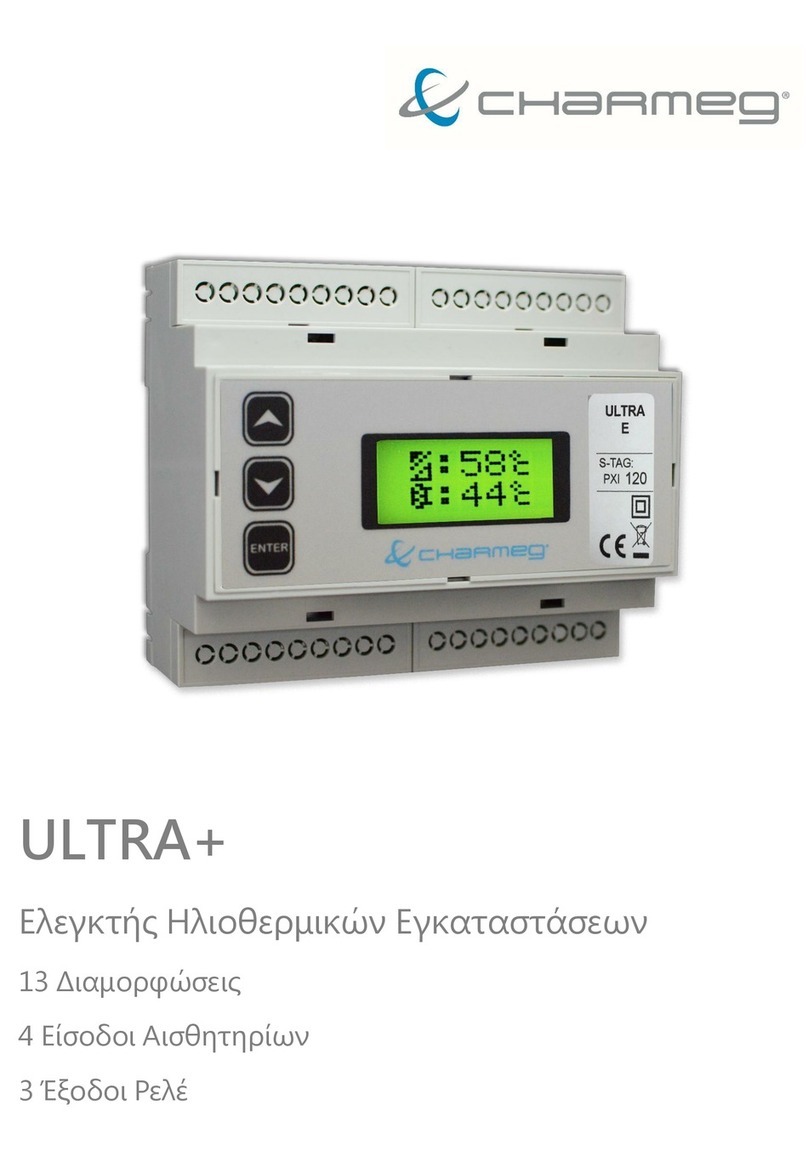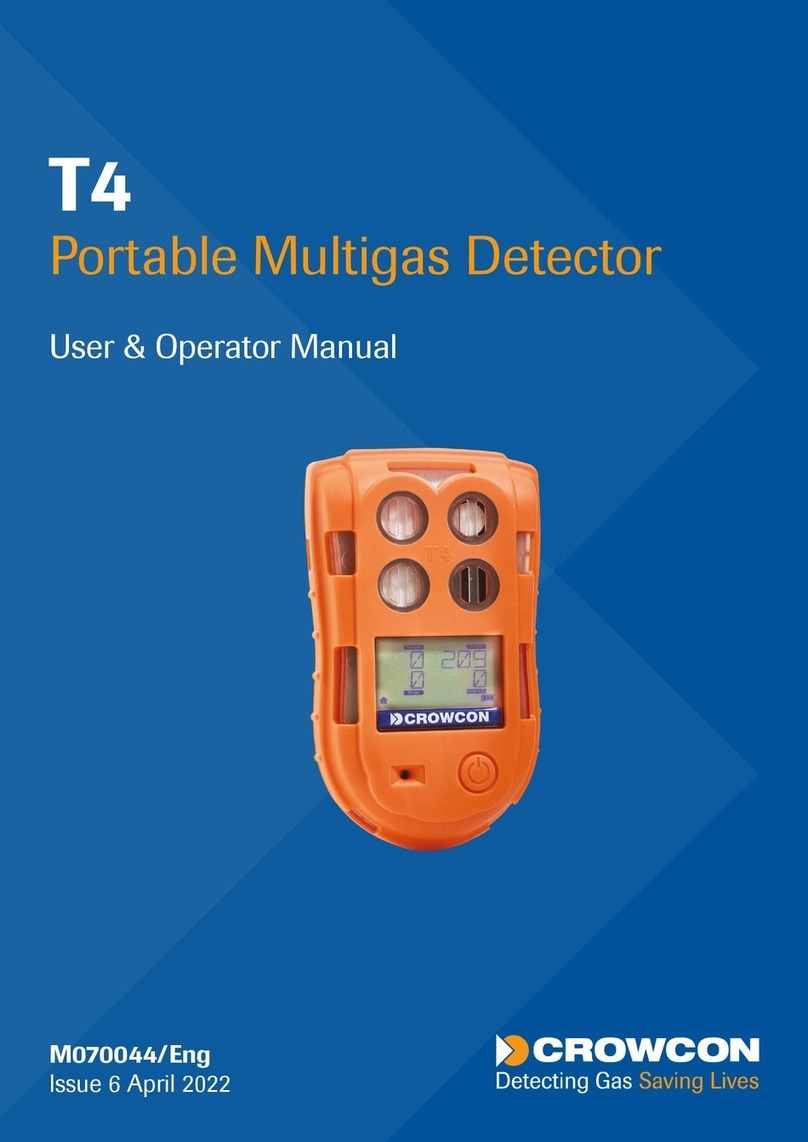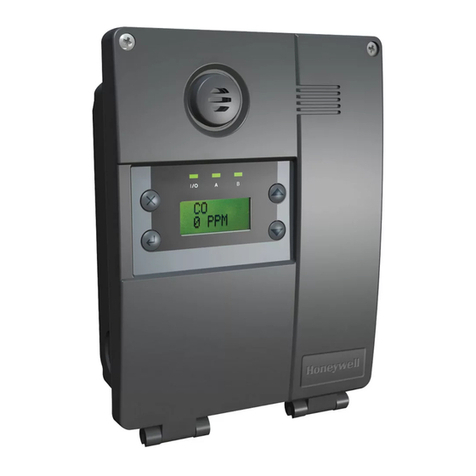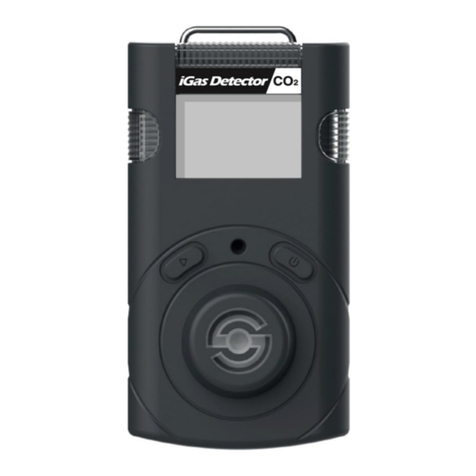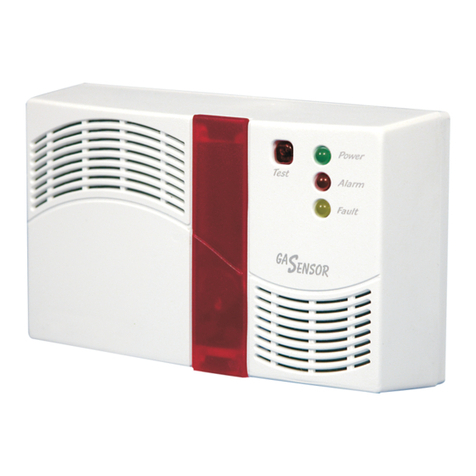Prosense PC3 Series User manual

1
PRS-UM-PC3-EN-Rev.04-06.2020
PROSENSE PC3 Series Gas Detectors
Installation and User Manual
Prosense Teknoloji San. Ltd. Şti.
Cumhuriyet Mah. Mermer Sok. No:16 Kartal/İstanbul TÜRKİYE
Tel: +(90) 216 306 77 88 Faks: +(90)216 473 81 29
www.prosense.com.tr

2
PRS-UM-PC3-EN-Rev.04-06.2020
WARNING!
This manual must be carefully read by all persons who have or will have the
responsibility for installing, using or servicing this product.
Like any equipment, this product will perform as designed only if installed,
used and serviced in accordance with the manufacturer’s instructions.
Otherwise, it could fail to perform as designed and persons who rely on this
product for their safety could suffer severe personal injury or death.
The warranties made by Prosense with respect to this product are voided if
the product is not installed, used and serviced in accordance with the
instructions in this user guide. Please protect yourself and other by following
them.
Important Remark
The detector has been factory-tested and calibrated before delivery. The
commissioning has to be terminated by a function test of the complete gas
detection system.

3
PRS-UM-PC3-EN-Rev.04-06.2020
Contents
For Your Safety ........................................................................................................................................... 4
Strictly Follow the Instructions for Use .............................................................................................. 4
Maintenance ...................................................................................................................................... 4
Use in Areas Subject To Explosion Hazards........................................................................................ 4
Liability for Proper Function or Damage ............................................................................................ 4
Intended Use ...................................................................................................................................... 4
Introduction................................................................................................................................................ 6
Detector Body............................................................................................................................................. 7
Sensor Head: .............................................................................................................................................. 7
Installation:................................................................................................................................................. 7
Mounting the Detector: ............................................................................................................................. 8
Electrical Connections ................................................................................................................................ 9
Cabling ...................................................................................................................................................... 11
Detector Grounding ................................................................................................................................. 12
Default Configuration............................................................................................................................... 13
Detector Configuration............................................................................................................................. 13
4-20 mA Output:....................................................................................................................................... 14
RS485 Serial MODBUS Output: ................................................................................................................ 14
Detector Relay Module: ........................................................................................................................... 16
System Status ........................................................................................................................................... 17
First Time Switch on (Commissioning) ..................................................................................................... 18
Calibration ................................................................................................................................................ 18
Zero Calibration .................................................................................................................................... 19
Span Calibration ................................................................................................................................... 19
Maintenance ............................................................................................................................................ 20
Proactive Maintenance: ....................................................................................................................... 20
Operational Life:................................................................................................................................... 20
Sensor Replacement:............................................................................................................................ 21
Sinter Replacement: ............................................................................................................................. 21
Sensor Head Replacement: .................................................................................................................. 21
General Specification ............................................................................................................................... 22
Certification .............................................................................................................................................. 23
Warranty Statement................................................................................................................................. 24

4
PRS-UM-PC3-EN-Rev.04-06.2020
For Your Safety
Ensure that this Operating Manual is read and understood BEFORE installing / operating /
maintaining the equipment. Pay particular attention to Warnings and Cautions. All document
Warnings are listed here and repeated where appropriate at the start of the relevant
chapter(s) of this Operating Manual. Cautions appear in the sections/sub-sections of the
document where they apply.
Strictly Follow the Instructions for Use
Any use of the detectors requires full understanding and strict observation of these
instructions. The detector is only to be used for purposes specified here.
Maintenance
It is recommended to obtain a service contract Prosense to carry out all repairs. Only
authentic Prosense spare parts should be used for maintenance. Please check “Maintenance”
section for more details.
Use in Areas Subject To Explosion Hazards
Equipment or components which are used in potentially explosive atmospheres and have
been tested and approved according to international or European regulations may be used
only under the conditions specified here. Modifications of components or the use of faulty or
incomplete parts are not permitted. In case of repairs of equipment or components, the
national regulations must be observed.
Liability for Proper Function or Damage
The liability for the proper function of the detector is irrevocably transferred to the owner or
operator to the extent that the detector is serviced or repaired by personnel not employed or
authorized by Prosense or if the sensing head is used in a manner not conforming to its
intended use. Prosense cannot be held responsible for damage caused by non-compliance
with the recommendations given above. The warranty and liability provisions of the terms of
sale and delivery of Prosense are likewise not modified by the recommendations given above.
Intended Use
The PC3 series detectors are intended to be used for stationary, continuous monitoring for
combustible and toxic gas/air or vapour/air mixtures and oxygen under atmospheric
conditions. According to the ATEX Directive 2014/34/EU the device category is III. Thus this
detector is suitable to be operated in Zone 2.
Hazardous area classifications:
Zone 0: An area classified as Zone 0 will have ignitable concentrations of flammable gases,
vapours or liquids either continuously present or present for long periods of time under
normal operating conditions

5
PRS-UM-PC3-EN-Rev.04-06.2020
Zone 1: An area classified as Zone 1 is likely to have ignitable concentrations of flammable
gases, vapours or liquids present under normal operating conditions. Flameproof (Ex db)
detectors are suitable for use in Zone 1.
Zone 2: An area classified as Zone 2 is not likely to have ignitable concentrations of flammable
gases, vapours or liquids present under normal operating conditions. Flameproof (Ex db)
detectors are suitable for use in Zone 2.
Not to be used in oxygen enriched atmospheres.
In conjunction with the central controllers Prosense detectors with preadjusted alarm
thresholds audible and visible alarm devices or automatic countermeasures can be activated
before the detected gases or vapours can form dangerous flammable or toxic mixtures with
air.
Please be alerted in following special conditions may have impact on measuring function due
to the nature of measuring method:
1. Very High Gas Concentrations
The measuring method based on heat produced by reaction on the catalytic oxidation of a
flammable gas when pellistor sensor used. In case of high gas concentrations there is not
enough oxygen in the sensor to perform oxidation process correctly. Hence the measuring
signal decreases at high gas concentrations and even can lead to measuring signal within the
measuring range again. In this case do not reset latching alarms without having ensured a
safe condition by means of an independent gas concentrations measurement.
2. Minimum Oxygen Concentration
The measuring principle of heat of reaction needs a minimum oxygen concentration of 15 %
by volume; otherwise the measuring values will be too low because of oxygen deficiency.
3. Long-term Gassing With Methane at Very Low Temperatures
If the Prosense PC3 series flammable gas detectors are operated applying with methane at
very low temperatures, the measuring signal at long-term exposition may decrease after
alarm activation and may lead to misinterpretation. In this conditions if a gas alarm occurs,
necessary actions need to be taken immediately. The decrease of the measuring signal
should not mean that the gas concentration has been decreased. We recommend to keep
alarms on the associated controllers and not to reset these alarms without making sure
conditions are safe.

6
PRS-UM-PC3-EN-Rev.04-06.2020
Introduction
The Prosense comprises a gas detector body and a choice of sensors heads for detecting
flammable gas, toxic gas and oxygen. The construction of Prosense PC3 Series detectors
allows it to be used in Zone2 or other areas not classified as hazardous.
Prosense detectors can be configured with a wide range of different sensors may be used to
detect a broader range of target gases. The detector can be configured with optional relay
board features three programmable relays for controlling external equipment e.g. alarms,
sirens, valves or switches. The detector provides an industry standard 3-wire, 4-20mA output
for connection to a dedicated gas detection control system or PLC.
Prosense detectors comprises of the main parts as shown below:
Diagram 1: Exploded view
Field cable entries x2
Cover
Body
Sensor head socket
Sensor head body
Sensor holder
Sinter
Sensor head cab
Sinter nut
Locking grub screw
Body mounting screw location

7
PRS-UM-PC3-EN-Rev.04-06.2020
Detector Body
The detector enclosure has two threaded entries. One is at upper part of the transmitter
housing are for connecting the power source, signal output and relay contacts to associated
signalling equipment. The bottom entry allows direct connection of the sensor socket. There
are three special screw locations to mount detector to wall. The detector body dimensions are
given in Diagram 2.
Diagram 2: Detector body dimensions
Sensor Head:
The Prosense sensor head designed to detect flammable, toxic and oxygen gases. Sensor head
may include electro catalytic or electrochemical sensors. PC3 Series uses SH20 sensor head
and components are given in Diagram 1.
Installation:
Gas detectors should be mounted where a potential hazard of gas is most likely to be present.
The following points should be noted when locating gas sensors.
•When locating detectors consider the possible damage caused by natural events e.g.
rain or flooding.
•Consider ease of access to the gas detector for functional testing and servicing.
•Consider how escaping gas may behave due to natural or forced air currents.
Note: The placement of gas detectors should be determined following the advice of experts
having specialist knowledge of gas dispersion, experts having knowledge of the process plant
system and equipment involved safety and engineering personnel. The agreement reached
on the location of detectors should be recorded.

8
PRS-UM-PC3-EN-Rev.04-06.2020
Each gas has different nature depending on their density. The density of which is lower than
air, such as hydrogen, methane or ammonia the sensor head must be located above a possible
leak or at the highest points at which major concentrations of gas may be found. The gases
and vapours with a density greater than air, the sensor head must be installed beneath a
possible leak or at the lowest points at which such gases and vapours may be present.
Prosense may provide cable gland together with detector in regards to customer requests.
The cable gland provided by Prosense has ATEX certification and provides at least IP65 level
protection. The cable glands are only suitable for fixed installations. Cables shall be effectively
clamped to prevent pulling or twisting. To provide necessary protection cable gland coupling
should be fixed with 20Nm torque when used with three sealings; 18Nm when used with two
sealing; 16Nm when used with one sealing. It is the final assemblers/users responsibility to
ensure the threaded joint between cable gland and the enclosure meet all the requirements
of the applicable standards for the assembly. Cable gland sealing are suitable for the circular
type cables. If other shaped cables will be used the sealing should be replaced with suitable
ones. The cable glands provided by Prosense are suitable to use temperature range in which
detector works.
Mounting the Detector:
The detector should be mounted vertically as the sensor head pointing downwards. Detector
has to be mounted such that the sensor's gas entrance area. The install location
•should be isolated from vibration, direct sun light and have temperature stability
•avoided external influences such as splashing water, oil, corrosive aerosols
•should have at least 30 cm free space beneath the sensor head to provide
accessibility for calibration work.
•should be in air flow between possible leak or collection point and possible source of
ignition.
Prosense do not recommend installing detectors to:
•directly above a cooking unit,
•directly above a sink unit,
•close to an extractor unit,
•outdoor without protection against the rain,
•in places where temperature is outside the admissible operating range,
•in corrosive environments,
•inside air vents.
•in environments where silicon can be found.

9
PRS-UM-PC3-EN-Rev.04-06.2020
The Prosense PC3 detector has three mounting screw locations on body as given in Diagram 3.
Diagram 3: PC3 detector mounting screw locations
Electrical Connections
Caution: All electrical connections should be made in accordance with any relevant local or
national legislation, standards or codes of practice.
Prosense detectors can operate between 12 - 24 VDC. The connection socket located on main
board as given in Diagram 7 and details given in below table 2:
Output
Usage
V +
Power input (+) 12VDC – 24VDC
V -
Power input (-)
S
Current Output Signal (4mA – 20mA)
Table 1: Detector output ports and their usage
The detector designed to give 4 - 20 mA current output signal. It is also possible to get
voltage value via using an additional resistor. Below table 3 gives recommended resistor
specifications to get correct voltage output from detector depending of the power source
level:
Detector Power VDC
Resistor
Signal level (4mA – 20mA)
12 VDC – 24 VDC
250 Ω, tolerance %1
1 VDC – 5 VDC
12 VDC – 24 VDC
500 Ω, tolerance %1
2 VDC – 10 VDC
Table 2: Detector power and the output resistor
Please consider the cable length when performing installation in the field. The Prosense
detector requires a power supply between 12VDC and 24VDC. Make sure that a minimum 12
VDC supply available at the detector entrance and consider the voltage drop due to cable
resistance in case of long distance applications.
Body mounting screw location
Body mounting screw location
Body mounting screw location

10
PRS-UM-PC3-EN-Rev.04-06.2020
The maximum loop resistance in the field cable is calculated as follows:
R loop = (V controller – V detector min) / I detector
Example;
Diagram 4: Field cabling
The controller or power supply is supplying a nominal 24VDC (V controller), the detector
minimum allowable voltage is 12VDC (V detector min), therefore the maximum allowable
voltage drop between the controller and detector is 12VDC; this means a voltage drop of 6V in
each core (V+ core and V- core). Minimum power consumption of the detector without any
optional module is 1W. The current required to drive the detector at the minimum voltage is (I
= P / V): 1.0 / 12 = 85mA (I detector).
Maximum power consumption of the detector when optional relay modules installed and all
relays are active is 5.0W. The current required to drive the detector at the minimum voltage is
(I = P / V): 5.0 / 12 = 416.6mA (I detector). So, the maximum field cable loop resistance (R
loop) = 12 / 0.41 = 29 Ohms, or 15 Ohms per core, (allowing for component variations, losses,
etc.).
The following tables show the maximum cable distances between the controller and
transmitter assuming a voltage drop of 6V in each core and for different cable parameters.
The tables are examples only and actual cable parameters and source power supply voltage
for the application should be used to calculate the maximum cable distance allowed at the
installation site. Typical cable data for detector with relay module
Cable size
Cable type
Cable resistance
Maximum Cable length (L)
(cross sectional area)
nearest equivalent
Ω/km
Meters
0.5mm2
20AWG
36.8 Ω/km
407
1.0mm2
17AWG
19.5 Ω/km
769
1.5mm2
16AWG
12.7 Ω/km
1181
2.0mm2
14AWG
10.1 Ω/km
1485
2.5mm2
13AWG
8.0 Ω/km
1875
Table 3: Typical cable details and maximum distance for cabling

11
PRS-UM-PC3-EN-Rev.04-06.2020
Cabling
The use of industrial grade, suitably shielded field cable is recommended. The best practices
shown that, screened 3 cores (plus screen 90% coverage), suitably mechanically protected
copper cable with a suitable explosion-proof gland, or ¾” NPT steel conduit, depending on the
distance between signal received or control panel and detector 0.5 to 2.5 mm2 (20 to 13
AWG) conductors can give better results. Ensure the cable gland is installed correctly and fully
tightened.
Cable and Earth/Ground regimes
Effective Earth/Ground bonding is important to ensure good EMC and RFI immunity. The
following diagrams show examples of how to earth/ground bond the cable at enclosures. The
same principles apply to conduit installations. These bonding techniques provide good
RFI/EMC performance. Earth/ground loops must be avoided to prevent the risk of false signal
variation.
Diagram 5: Grounding
The Earth Screen of the field cable should be “tied to Earth” or connected to Ground at one
point only. It is common practise to adopt a STAR EARTH connection regime where all
instrumentation Screens are connected at one common point. The Screen at the other end of
the cable should be “parked” or terminated into a blank terminal.

12
PRS-UM-PC3-EN-Rev.04-06.2020
Detector Grounding
Internal Ground connection: Each detector has grounding screw which utilizes grounding for
detector main PCB to detector body. The screw should be located correctly and fixed for all
times. In case of any maintenance activity this screw should be checked and fixed to make
sure for proper grounding.
External Ground Connection: It is recommended to utilize a No 14 AWG copper, (Stranded or
Solid), wire. Loosen the screw sufficiently to enable ‘wrapping the wire around the screw in a
“U” shape. Raise the clamp and place the wire between the clamp and ground base, lower the
clamp and tighten the screw to 10.4lb-in torque.
Diagram 6: Detector grounding screw
External
Grounding
screw
Internal
Grounding
screw

13
PRS-UM-PC3-EN-Rev.04-06.2020
Default Configuration
Prosense detectors preconfigured to provide signal from analogue output depending on the
detector and gas type. The output signal levels are given in below:
Function
Value/Setting
Meaning
2.0 mA
Fault
2.0 mA to 2.5 mA
Warm-up
Signal output
4.0 mA to 20.0 mA
Normal gas measurement
21.0 mA
Maximum over range
Table 4: Detector default configuration details
Detector Main board and connection details given in Diagram 7:
Diagram 7: Detector main board and connections
Sensor connections are input to detector main board and already connected to sensor inside
the sensor head. Sensor connections must never be disconnected or changed. Only detector
connections (V+, V- and S or RS485 A-B) must be used for external connections.
Detector Configuration
The Prosense detector has three different types of connection depending on usage:
1. 4-20mA output
2. RS485 Modbus serial communication output
3. 3-Relay outputs
Sensor Connections
Relay Module socket
Calibration adjustment buttons
Detector connections
Address switches
Power LED
Fault LED
RS485 Connections
S V- V+
B A

14
PRS-UM-PC3-EN-Rev.04-06.2020
It is possible to use 4-20 mA output with other output options at same time. The detector
power connections are located on main board and this connection must be done in any case
even 4-20mA analogue output is not used
4-20 mA Output:
The default configuration provides single 4-20mA signal output. Prosense detectors can be
connected to control panels on the market having 4-20mA input signal. Signal wiring from
detector and the control panel should be carried out by shielded cables. Wires cross section
depends on the distance between the control panel and the detector. The details given in
power cabling are valid as well for signal output. We recommend to use values given in table 4
(see page 13) as cabling best practices. Please avoid any interruption in case any junctions on
wires. The shield is to be grounded from the control panel side only and never connect the
shield to the detector. Please make sure clutching or crimping apparatus are not loosen or
oxidized.
Port
Usage
V +
Power input (+) 12VDC – 24VDC
V -
Power input (-)
S
Current Output Signal (4mA – 20mA)
Table 5: Detector 4-20mA output ports and their usage
RS485 Serial MODBUS Output:
PC3 Series detector has onboard RS485 communication feature and RS485 MODBUS
connections are located onboard on a separated socket. The detector connection should be
made by 4 wire that 2 for power and 2 for RS485. The total length of the connection line
should not exceed 800 meters. The wiring for detectors utilized with RS485 board should be
done by using connection cable EIA RS485 2 core wires with section 0.22 / 0.35 mm2 and
shielded. Nominal capacity between the wires should < 50pF/m and nominal impedance is
120 Ohms.
Port
Usage
V +
Power input (+) 12VDC – 24VDC
V -
Power input (-)
A
MODBUS RS485-A
B
MODBUS RS485-B
Table 6: Detector RS485 output ports and their usage
Detectors will be wired in daisy chain (bus) mode. We recommend not using star mode
connection due to negative impact of interference. Each detector should have unique address
number in the chain. The detectors would not be recognised by control panel if same address
given to them. The address of detector can be adjusted via using DIP-Switch set on the board:

15
PRS-UM-PC3-EN-Rev.04-06.2020
Diagram 8: RS485 Modbus serial communication address and switch position
The last detector in the chain should have 120 Ohm RS485 termination resistor. The resistor
is already implemented on the board by default but not activated. User should activate the
termination resistor via using the termination pin once the installation completed.
The power connection we recommend to use separate 2 wire cable with specification given
earlier in this document (see Electrical Connections section at page11). Once the cabling is
completed please check each detector has at least 12 VDC power.

16
PRS-UM-PC3-EN-Rev.04-06.2020
Detector Relay Module:
The relay module details are given below:
Diagram 9: Relay module
The relay board has 3 relay outputs:
Port
Usage
Energy
Contact
Fault
Fault Relay output
Energised
NO
Al1
Alarm 1 Relay output
Non-Energised
NO
Al2
Alarm 2 Relay output
Non-Energised
NO
Table 7 : Relay module output ports and their usage
All output pins located on Prosense IR detector can be used simultaneously. That means user
can use all relay outputs, analogue (4-20mA) output and RS485 digital output at same time if
implementation equipment allows their usage.
Each relay has 3 pins to adjust how to behave in case of alarm which are
NO : Normally Open
NC : Normally Close
The relay output pin positions shown below:
Normally Open (NO)
Normally Close (NC)
Table 8 : Relay output pin positions
Fault Relay output pins
Alarm1, Alarm2 and Fault LEDs
Power LED
Alarm1 Relay output pins
Alarm2 Relay output pins
Main board connection
SW1 and SW2
Alarm level adjustment pins
NO/NC adjustment pins for each relay

17
PRS-UM-PC3-EN-Rev.04-06.2020
The Fault relay is set to NO (Normally Open – Energised) and energised. Hence fault relay
LED is always active. It does not mean that there is a fault on detector. If the power LED is
active and fault LED is off it means that there is a fault condition on the detector. The fault
relay will be de-energized in case of power failure.
The alarm relays set to NO (Normally Open – De-Energised) position at factory.
The alarm levels are also adjustable via using SW1 and SW2 alarm level pins. Alarm levels are
defined as percentage in LEL for flammable gases. The alarm levels can be adjusted using
jumpers to switch SW1 and SW2. Possible options are given in table 9:
SW1
SW2
Al1 Level
Al2 Level
Open
Open
10 LEL
15 LEL
Open
Closed
10 LEL
20 LEL
Closed
Closed
20 LEL
25 LEL
Closed
Open
20 LEL
40 LEL
Table 9: Alarm level pin positions
Oxygen Detectors:
For oxygen detectors the output values and meanings are different as oxygen is naturally
available in atmosphere:
Port
Usage
Energy
Contact
Fault
Fault Relay output
Energised
NO
AL1
Alarm 1 Relay output - Lower level for Oxygen
Non-Energised
NO
AL2
Alarm 2 Relay output - Higher level for Oxygen
Non-Energised
NO
Table 10: Relay module output meanings for Oxygen detectors
Alarm levels are also different as given in below table:
SW1
SW2
Al1 Level
Al2 Level
Open
Open
19 %vol
23 %vol
Open
Closed
19 %vol
22 %vol
Closed
Closed
18 %vol
22 %vol
Closed
Open
18 %vol
23 %vol
Table 11: Alarm level (% Vol) pin positions for Oxygen detectors
System Status
The Prosense PC3 detector has two LEDs on main board. Red LED shows system power status
and yellow LED shows fault status. Both LEDs will be illuminated right after applying power.
After approximately 90 sec the yellow LED will be turned off and only red LED will continue
blinking. This status means that detector is ready to normal operation. Detector will provide

18
PRS-UM-PC3-EN-Rev.04-06.2020
2mA analogue signal output during warm-up period and current level will be 4mA after warm-
up.
Here is the LED status table during warm-up, normal operation and fault status:
LED
Warm-up
Normal Operation
Fault Status
Power -Red
Blinking
Blinking
Blinking
Fault - Yellow
Blinking
Solid - Off
Solid - On
Table 12: LED status details
First Time Switch on (Commissioning)
WARNING: The following procedure requires the detector Cover to be removed while carrying
out supply voltage checks. Therefore the appropriate permits to work should be sought in
preparation. Prior to carrying out any HOT WORK ensure local and site procedures are
followed. Ensure that the associated control panel output actuation is inhibited so as to
prevent false alarms. The following procedure should be followed carefully and only
performed by suitably trained personnel
1. Remove the detector cover
2. Configure the analogue output signal and power input connections correctly
3. Check that all electrical connections are terminated correctly
4. Switch On the external power supply to feed the detector
5. Using a Digital Multi Meter (DMM), check the Supply Voltage at the terminals V+ (24V)
and V- (0V), this should be a minimum supply voltage of 12VDC (Maximum supply
voltage is 24VDC)
6. Check LED status on detector main board. Both LEDs will be illuminated right after
applying power.
7. Wait two minutes and confirm that the yellow LED turned off and only red LED blinking.
8. Switch Off the external power to the detector.
9. Fit the cover and make sure none of the cables cause an obstruction while fitting cover
10. Switch on external power to the detector.
Calibration
It is recommended to periodically carry out calibration to ensure correct operation. Detector
should be powered and stabilized for at least 4 hours before calibration. For Flammable gas
calibration use a calibration gas concentration of between 25%LEL and 75%LEL to ensure that
the required accuracy can be attained. To calibrate the detector, use an appropriate span gas
cylinder, constant flow regulator and Prosense Gas Cap. The calibration gas flow rate should
be 0.5 L/min. It is recommended to use a compressed air cylinder (20.9%Vol oxygen) to
perform the zero calibration if the area where the detector is located contains any residual
amount of the target gas. If no residual gas is present then the background air can be used to
perform the zero calibration. Calibration procedure should be completed for both zero and
span adjustment steps. Calibration switches and adjustment buttons will be used on main
board during calibration.

19
PRS-UM-PC3-EN-Rev.04-06.2020
Diagram 10: Calibration buttons
Zero Calibration
The detector signal output should be 4 mA when there is no target gas exist on the area or a
clean compressed air applied to detector. Use a multimeter to check signal output. If the
signal output is different than 4 mA, enable the zero calibration via pressing to the zero
calibration button for 10 seconds. Zero calibration switch is shown on Diagram 8. After
holding it pressed for 10 seconds, the red power LED will be solid lit meaning zero calibration
process is started. The detector automatically adjusts the output signal level to 4 mA for the
next 30 seconds, assuming the detector is in a fresh air environment. If the ambient air is not
clean, clean air cylinder should be used to give clean air to the sensor head at a constant
speed of 0.5 lt/min using the calibration head. After 30 seconds, the detector completes the
zero calibration process and the power LED flashes once per second at normal speed.
Span Calibration
Span calibration must be done by exposing the detector a known gas. In first step zero
calibration should be completed. The current level should be monitored continuously at the
detector output using a measuring instrument DMM. Then, the calibration head should be
attached to the sensor head and gas should be applied to the sensor using a regulator at a
constant flow rate of 0.5lt / min. The span calibration button shown in Diagram-8 must be
pressed for 10 seconds to start the span calibration. After holding it pressed for 10 seconds,
the red power LED will be solid lit meaning the span calibration process is started. Depending
Zero Calibration button
Span Calibration button

20
PRS-UM-PC3-EN-Rev.04-06.2020
on the concentration level of the gas used for calibration, the current value measured at the
detector output will be different. Span calibration lasts 30 seconds. If the value measured
from the detector is higher than the reference value while applying gas, the zero calibration
button should be pressed until the current level is reduced to the reference value. If the
measured value is lower than the reference value, the span calibration button must be
pressed until the current level is increased to the reference value. The button functions
changes automatically when the span calibration process has started: zero calibration button
decreases the current level and span calibration button increases the current level. After 30
seconds, the calibration will be completed automatically and the adjusted level will be saved.
When the span calibration is completed, gas flow should stop and calibration cap should be
removed from sensor head
Important: Do not press both buttons.
Maintenance
Important: All replacement actions (sensor, sinter, and sensor head) shall be done by
Prosense service personnel as it needs some special steps that should be performed in
laboratory environment.
Proactive Maintenance:
All gas detectors including both for flammable and toxic gases should have to pass a functional
test and calibration periodically according to industrial standards. The test results and
calibration reports should be recorded in maintenance books.
To make sure the detectors functioning correctly company should prepare detector check
procedures. The procedures should include daily, weekly and monthly check activities
depending of the environmental and process conditions. The control panels will report fault
condition in case detector analogue output provides signal 0-2,5mA levels. Also they will
report fault in case they could not communicate to the detector.
It might be necessary to perform bump test to make sure detectors responding correctly to
test gases. If any detector does not respond to the test gases, it should be removed from the
operations and send to service for repair. Detector sensor head should be clean and open to
gas diffusion without any obstacle. Sensor head should not be washed with pressurised water
or gases.
Operational Life:
Catalytic/Pellistor flammable gas sensor made by using the pellistor that suffer from a loss of
sensitivity when in the presence of poisons or inhibitors, e.g. silicones, sulphides, chlorine,
lead or halogenated hydrocarbons. The pellistor are poison resistant to maximize the
operational life of the Catalytic flammable sensor. A typical operating life, subject to the
presence of poisons/inhibitors and environment conditions is 48-60 months. The NDIR
(infrared) flammable gas sensor is not affected by the mentioned poisons hence has a longer
Table of contents
Other Prosense Gas Detector manuals
Popular Gas Detector manuals by other brands
RKI Instruments
RKI Instruments Beacon 3200 Operator's manual

Industrial Scientific
Industrial Scientific Oldham MX52 Commissioning, operating and maintenance manual
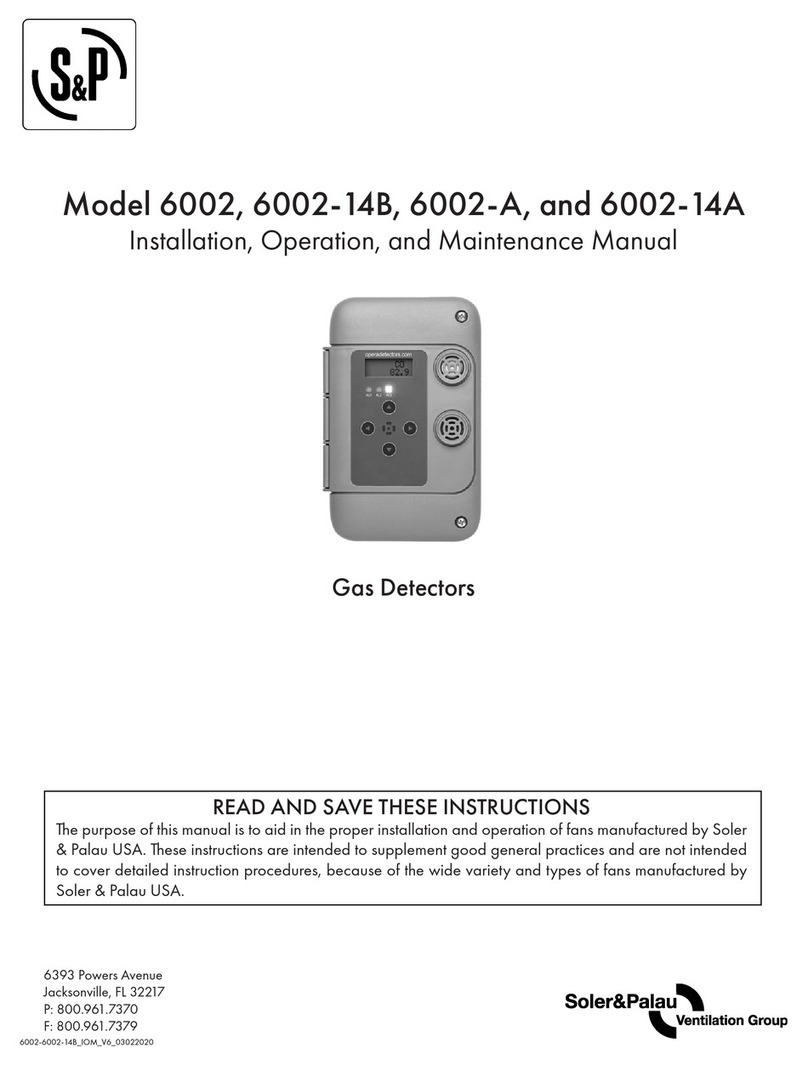
S&P
S&P 6002-A Installation, operation and maintenance manual
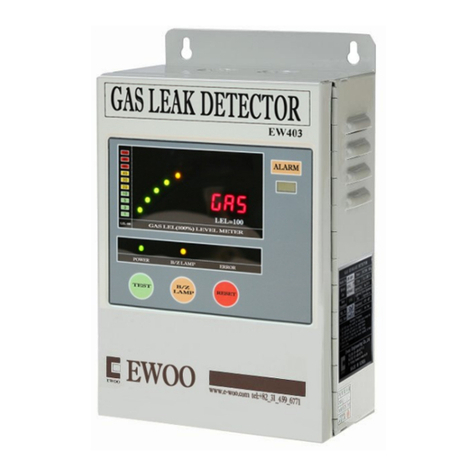
ewoo
ewoo EW-403 Reference manual
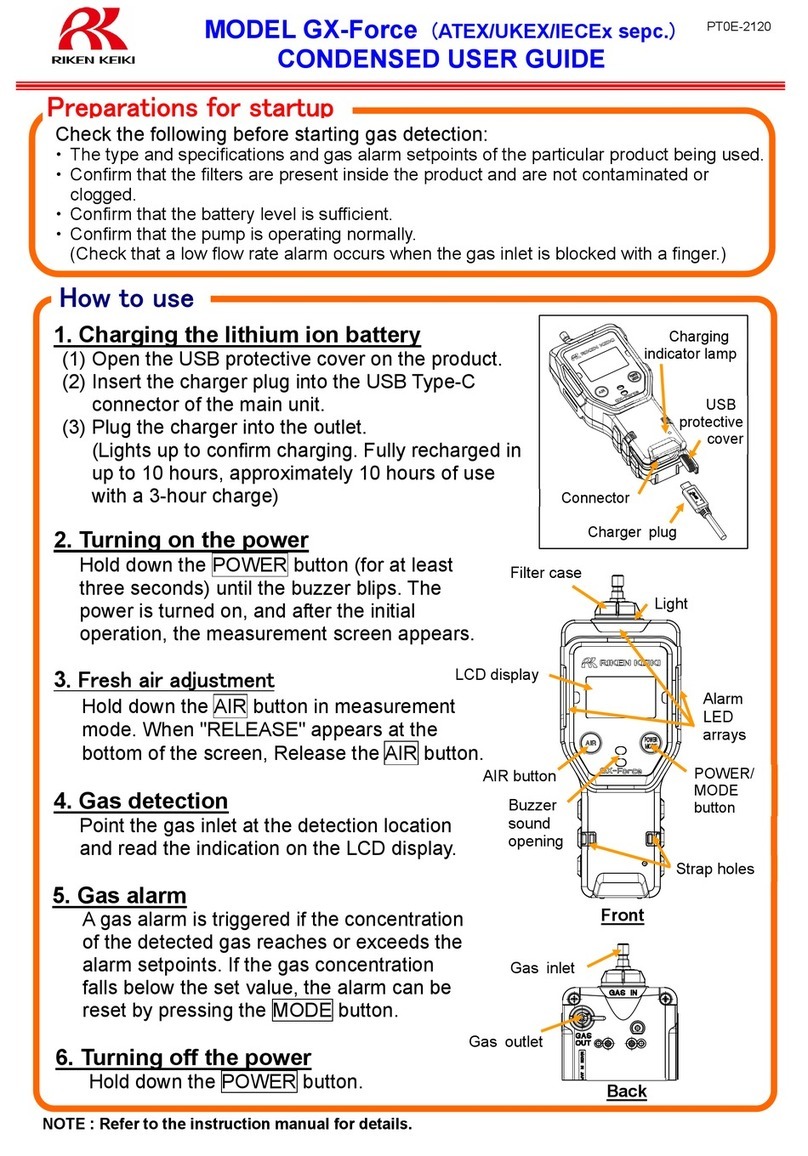
Riken Keiki
Riken Keiki GX-Force user guide
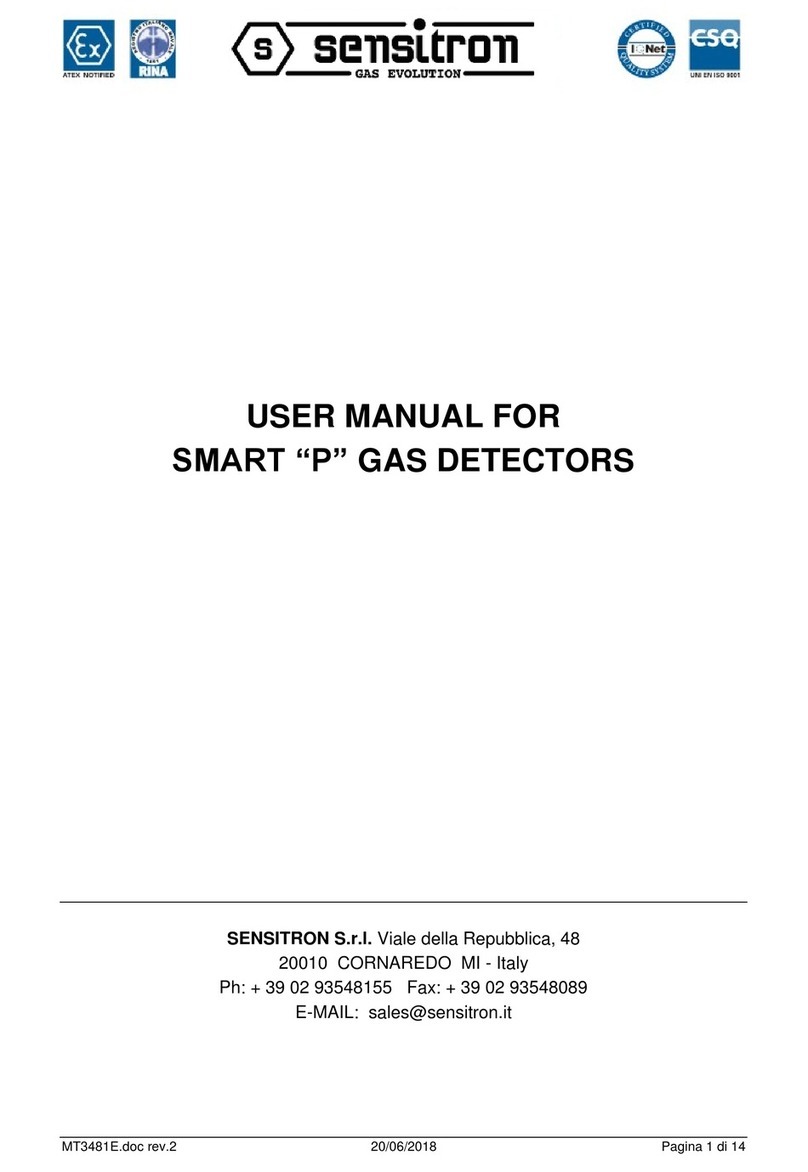
Sensitron
Sensitron P user manual
